Strategic Human Resource Management: Nestle's Ethical Culture Plan
VerifiedAdded on 2023/06/12
|9
|2082
|61
Essay
AI Summary
This essay analyzes Nestle's Human Resource Management (HRM) strategies, focusing on the strategic plan of creating an ethical, responsible, and high-performance culture. It examines how HR strategies are embedded within this plan, the rationale behind this integration, and methods Nestle can employ to achieve HR-related priorities. The essay also addresses contemporary HR challenges faced by Nestle Oceania, such as employee turnover and departmental conflicts, and proposes recommendations for overcoming these issues. Key achievements that can be realized through successful implementation of HR strategies are discussed, emphasizing employee retention, increased productivity, and enhanced organizational culture. The analysis concludes with suggestions for improving communication, resolving conflicts, and recruiting skilled employees to foster a more effective and ethical work environment within Nestle Oceania. This resource is available for students on Desklib, offering valuable insights and study tools.
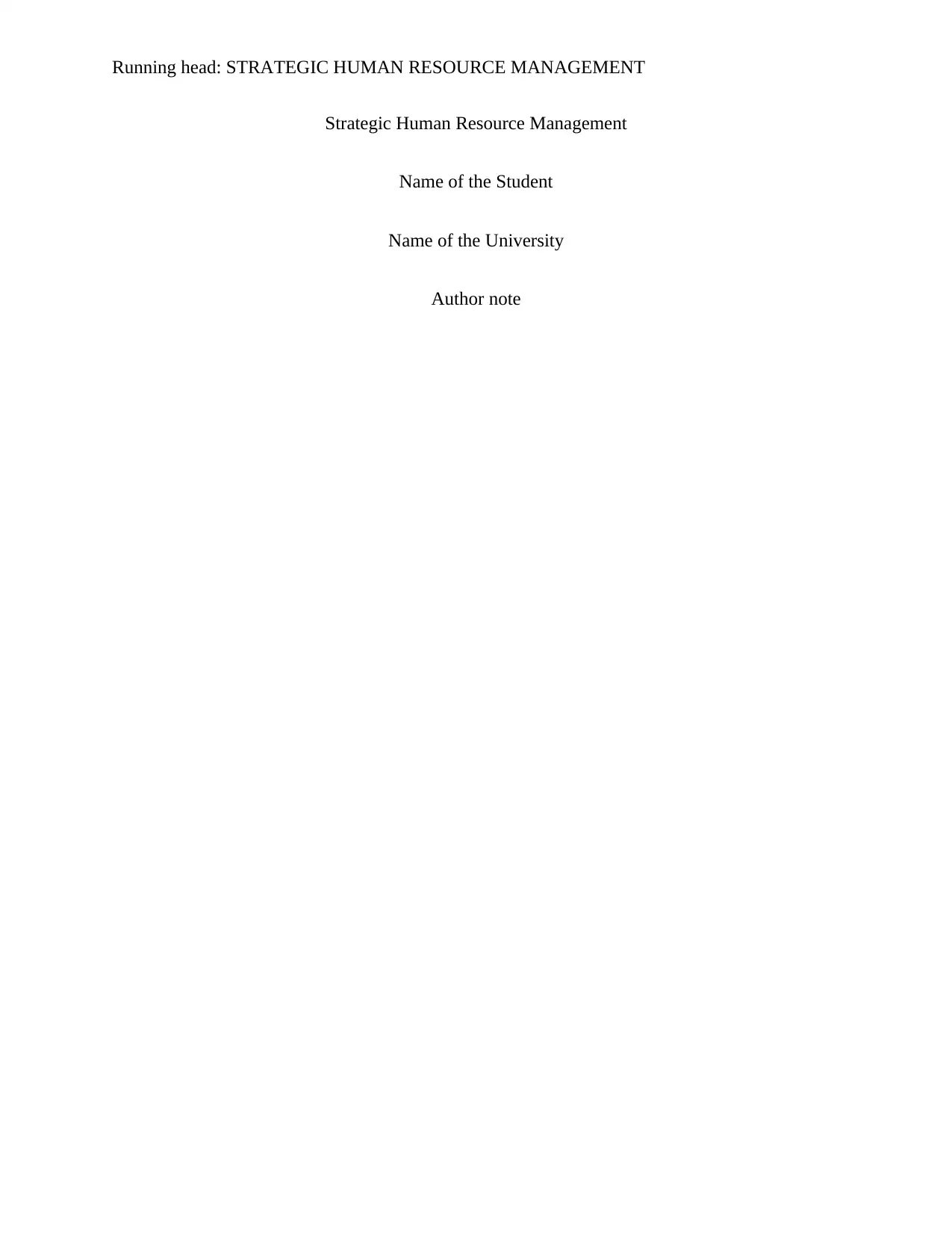
Running head: STRATEGIC HUMAN RESOURCE MANAGEMENT
Strategic Human Resource Management
Name of the Student
Name of the University
Author note
Strategic Human Resource Management
Name of the Student
Name of the University
Author note
Paraphrase This Document
Need a fresh take? Get an instant paraphrase of this document with our AI Paraphraser
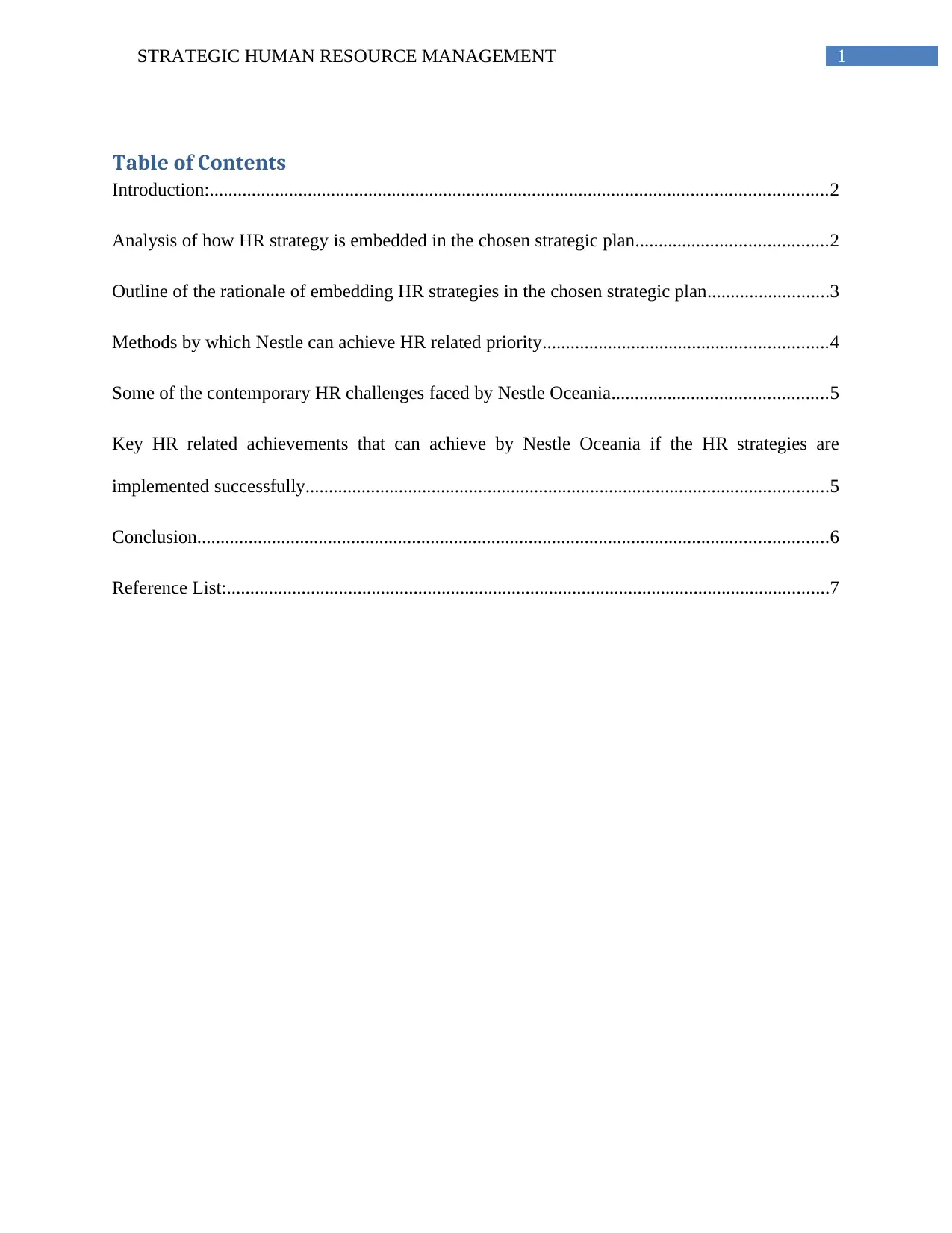
1STRATEGIC HUMAN RESOURCE MANAGEMENT
Table of Contents
Introduction:....................................................................................................................................2
Analysis of how HR strategy is embedded in the chosen strategic plan.........................................2
Outline of the rationale of embedding HR strategies in the chosen strategic plan..........................3
Methods by which Nestle can achieve HR related priority.............................................................4
Some of the contemporary HR challenges faced by Nestle Oceania..............................................5
Key HR related achievements that can achieve by Nestle Oceania if the HR strategies are
implemented successfully................................................................................................................5
Conclusion.......................................................................................................................................6
Reference List:.................................................................................................................................7
Table of Contents
Introduction:....................................................................................................................................2
Analysis of how HR strategy is embedded in the chosen strategic plan.........................................2
Outline of the rationale of embedding HR strategies in the chosen strategic plan..........................3
Methods by which Nestle can achieve HR related priority.............................................................4
Some of the contemporary HR challenges faced by Nestle Oceania..............................................5
Key HR related achievements that can achieve by Nestle Oceania if the HR strategies are
implemented successfully................................................................................................................5
Conclusion.......................................................................................................................................6
Reference List:.................................................................................................................................7
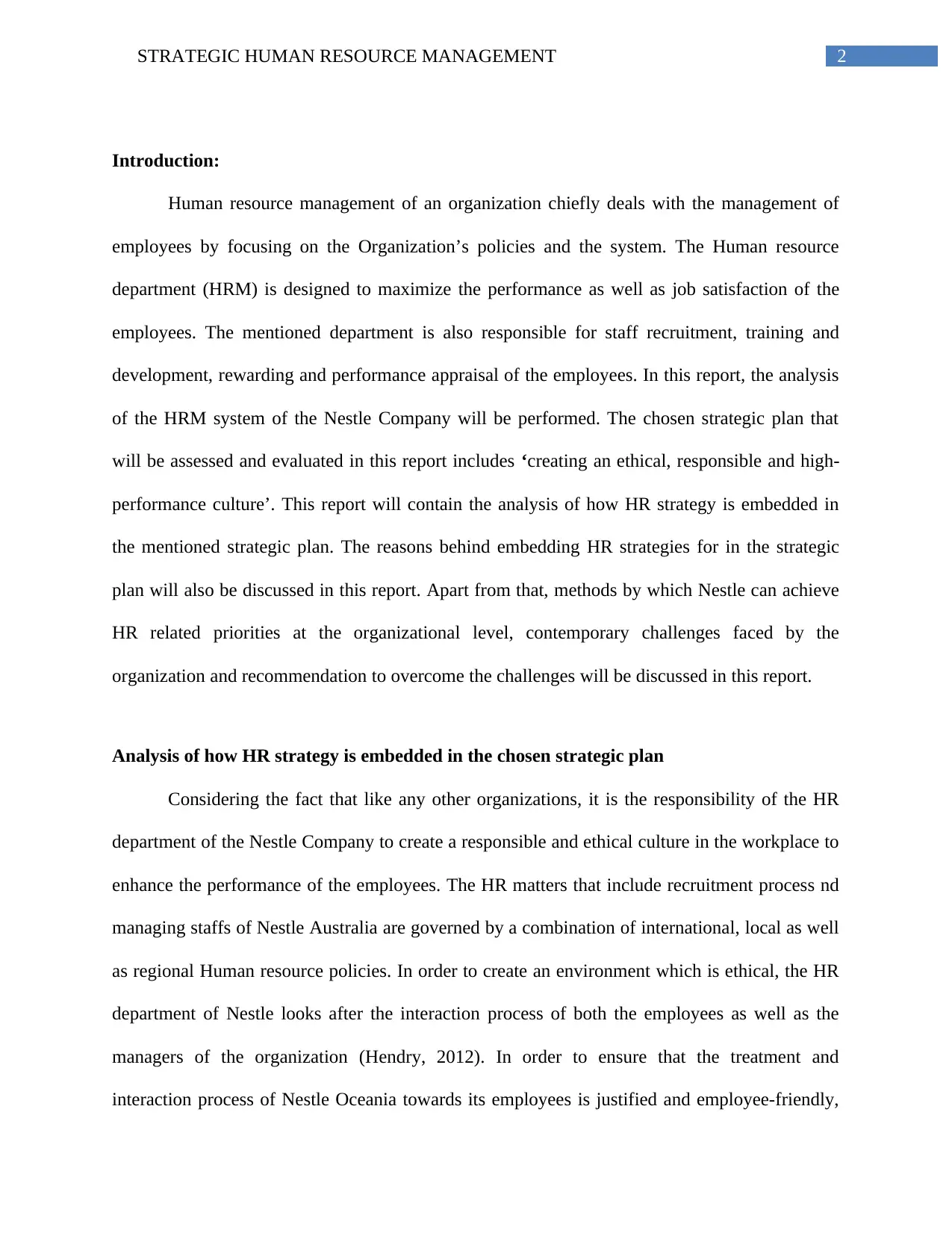
2STRATEGIC HUMAN RESOURCE MANAGEMENT
Introduction:
Human resource management of an organization chiefly deals with the management of
employees by focusing on the Organization’s policies and the system. The Human resource
department (HRM) is designed to maximize the performance as well as job satisfaction of the
employees. The mentioned department is also responsible for staff recruitment, training and
development, rewarding and performance appraisal of the employees. In this report, the analysis
of the HRM system of the Nestle Company will be performed. The chosen strategic plan that
will be assessed and evaluated in this report includes ‘creating an ethical, responsible and high-
performance culture’. This report will contain the analysis of how HR strategy is embedded in
the mentioned strategic plan. The reasons behind embedding HR strategies for in the strategic
plan will also be discussed in this report. Apart from that, methods by which Nestle can achieve
HR related priorities at the organizational level, contemporary challenges faced by the
organization and recommendation to overcome the challenges will be discussed in this report.
Analysis of how HR strategy is embedded in the chosen strategic plan
Considering the fact that like any other organizations, it is the responsibility of the HR
department of the Nestle Company to create a responsible and ethical culture in the workplace to
enhance the performance of the employees. The HR matters that include recruitment process nd
managing staffs of Nestle Australia are governed by a combination of international, local as well
as regional Human resource policies. In order to create an environment which is ethical, the HR
department of Nestle looks after the interaction process of both the employees as well as the
managers of the organization (Hendry, 2012). In order to ensure that the treatment and
interaction process of Nestle Oceania towards its employees is justified and employee-friendly,
Introduction:
Human resource management of an organization chiefly deals with the management of
employees by focusing on the Organization’s policies and the system. The Human resource
department (HRM) is designed to maximize the performance as well as job satisfaction of the
employees. The mentioned department is also responsible for staff recruitment, training and
development, rewarding and performance appraisal of the employees. In this report, the analysis
of the HRM system of the Nestle Company will be performed. The chosen strategic plan that
will be assessed and evaluated in this report includes ‘creating an ethical, responsible and high-
performance culture’. This report will contain the analysis of how HR strategy is embedded in
the mentioned strategic plan. The reasons behind embedding HR strategies for in the strategic
plan will also be discussed in this report. Apart from that, methods by which Nestle can achieve
HR related priorities at the organizational level, contemporary challenges faced by the
organization and recommendation to overcome the challenges will be discussed in this report.
Analysis of how HR strategy is embedded in the chosen strategic plan
Considering the fact that like any other organizations, it is the responsibility of the HR
department of the Nestle Company to create a responsible and ethical culture in the workplace to
enhance the performance of the employees. The HR matters that include recruitment process nd
managing staffs of Nestle Australia are governed by a combination of international, local as well
as regional Human resource policies. In order to create an environment which is ethical, the HR
department of Nestle looks after the interaction process of both the employees as well as the
managers of the organization (Hendry, 2012). In order to ensure that the treatment and
interaction process of Nestle Oceania towards its employees is justified and employee-friendly,
⊘ This is a preview!⊘
Do you want full access?
Subscribe today to unlock all pages.

Trusted by 1+ million students worldwide
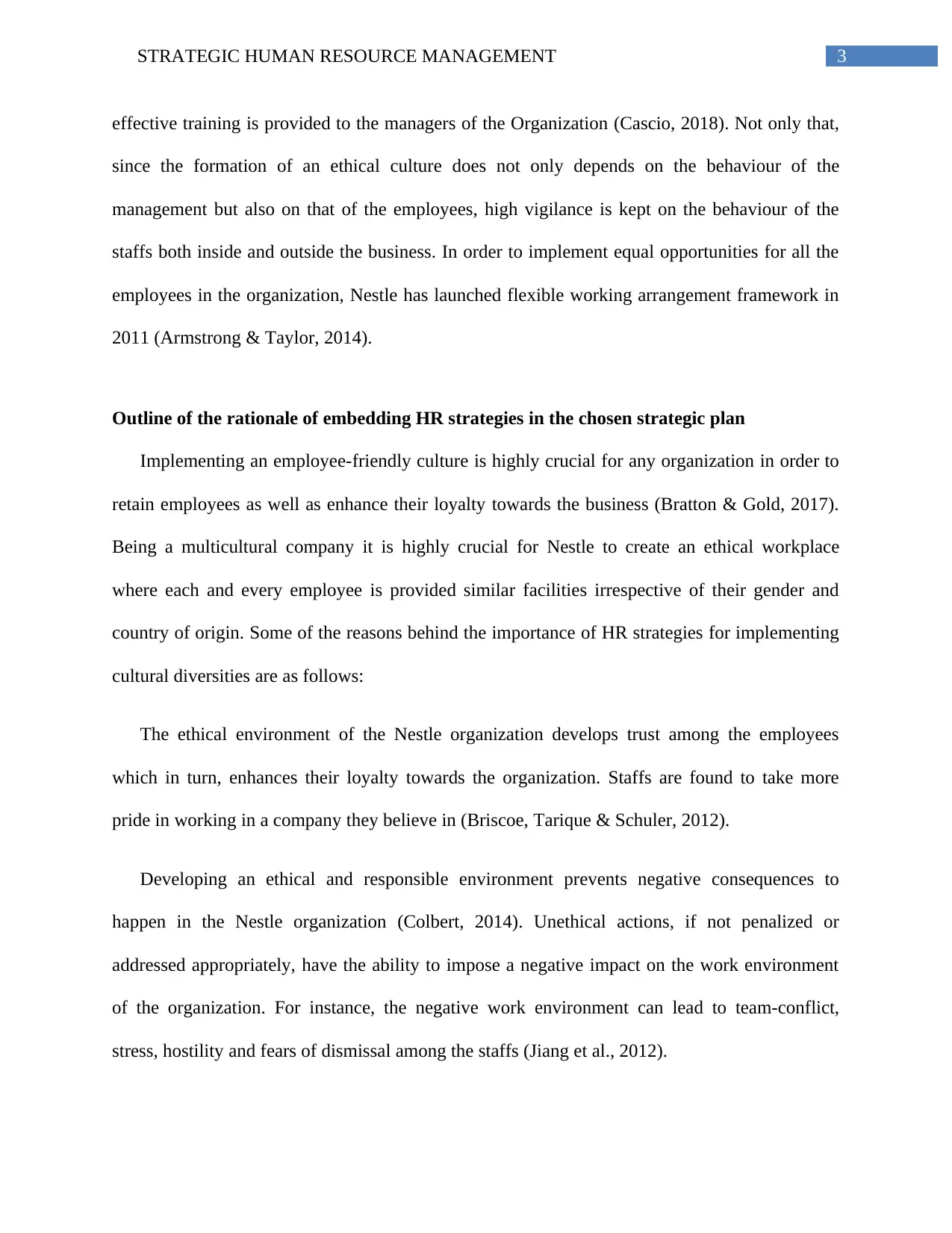
3STRATEGIC HUMAN RESOURCE MANAGEMENT
effective training is provided to the managers of the Organization (Cascio, 2018). Not only that,
since the formation of an ethical culture does not only depends on the behaviour of the
management but also on that of the employees, high vigilance is kept on the behaviour of the
staffs both inside and outside the business. In order to implement equal opportunities for all the
employees in the organization, Nestle has launched flexible working arrangement framework in
2011 (Armstrong & Taylor, 2014).
Outline of the rationale of embedding HR strategies in the chosen strategic plan
Implementing an employee-friendly culture is highly crucial for any organization in order to
retain employees as well as enhance their loyalty towards the business (Bratton & Gold, 2017).
Being a multicultural company it is highly crucial for Nestle to create an ethical workplace
where each and every employee is provided similar facilities irrespective of their gender and
country of origin. Some of the reasons behind the importance of HR strategies for implementing
cultural diversities are as follows:
The ethical environment of the Nestle organization develops trust among the employees
which in turn, enhances their loyalty towards the organization. Staffs are found to take more
pride in working in a company they believe in (Briscoe, Tarique & Schuler, 2012).
Developing an ethical and responsible environment prevents negative consequences to
happen in the Nestle organization (Colbert, 2014). Unethical actions, if not penalized or
addressed appropriately, have the ability to impose a negative impact on the work environment
of the organization. For instance, the negative work environment can lead to team-conflict,
stress, hostility and fears of dismissal among the staffs (Jiang et al., 2012).
effective training is provided to the managers of the Organization (Cascio, 2018). Not only that,
since the formation of an ethical culture does not only depends on the behaviour of the
management but also on that of the employees, high vigilance is kept on the behaviour of the
staffs both inside and outside the business. In order to implement equal opportunities for all the
employees in the organization, Nestle has launched flexible working arrangement framework in
2011 (Armstrong & Taylor, 2014).
Outline of the rationale of embedding HR strategies in the chosen strategic plan
Implementing an employee-friendly culture is highly crucial for any organization in order to
retain employees as well as enhance their loyalty towards the business (Bratton & Gold, 2017).
Being a multicultural company it is highly crucial for Nestle to create an ethical workplace
where each and every employee is provided similar facilities irrespective of their gender and
country of origin. Some of the reasons behind the importance of HR strategies for implementing
cultural diversities are as follows:
The ethical environment of the Nestle organization develops trust among the employees
which in turn, enhances their loyalty towards the organization. Staffs are found to take more
pride in working in a company they believe in (Briscoe, Tarique & Schuler, 2012).
Developing an ethical and responsible environment prevents negative consequences to
happen in the Nestle organization (Colbert, 2014). Unethical actions, if not penalized or
addressed appropriately, have the ability to impose a negative impact on the work environment
of the organization. For instance, the negative work environment can lead to team-conflict,
stress, hostility and fears of dismissal among the staffs (Jiang et al., 2012).
Paraphrase This Document
Need a fresh take? Get an instant paraphrase of this document with our AI Paraphraser
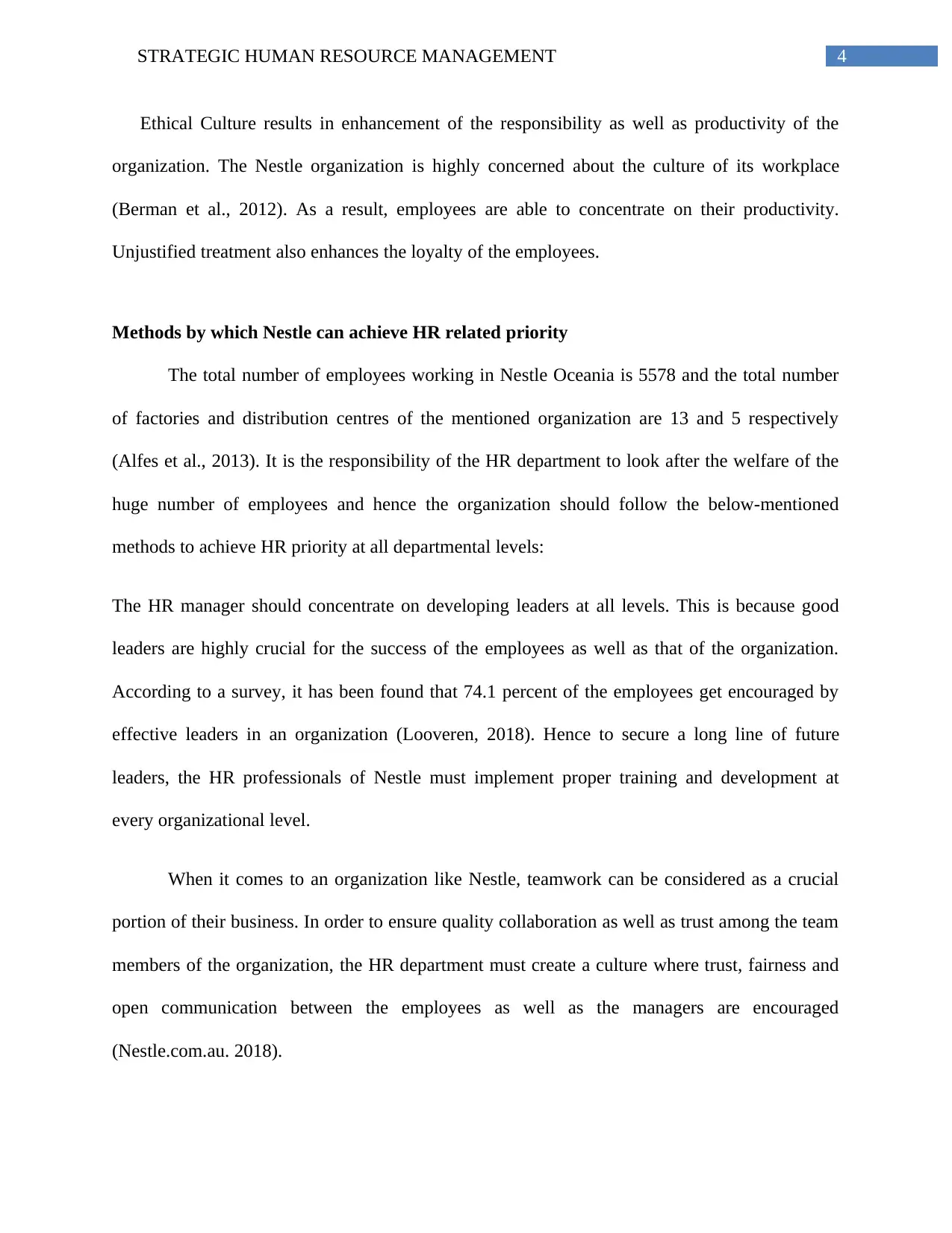
4STRATEGIC HUMAN RESOURCE MANAGEMENT
Ethical Culture results in enhancement of the responsibility as well as productivity of the
organization. The Nestle organization is highly concerned about the culture of its workplace
(Berman et al., 2012). As a result, employees are able to concentrate on their productivity.
Unjustified treatment also enhances the loyalty of the employees.
Methods by which Nestle can achieve HR related priority
The total number of employees working in Nestle Oceania is 5578 and the total number
of factories and distribution centres of the mentioned organization are 13 and 5 respectively
(Alfes et al., 2013). It is the responsibility of the HR department to look after the welfare of the
huge number of employees and hence the organization should follow the below-mentioned
methods to achieve HR priority at all departmental levels:
The HR manager should concentrate on developing leaders at all levels. This is because good
leaders are highly crucial for the success of the employees as well as that of the organization.
According to a survey, it has been found that 74.1 percent of the employees get encouraged by
effective leaders in an organization (Looveren, 2018). Hence to secure a long line of future
leaders, the HR professionals of Nestle must implement proper training and development at
every organizational level.
When it comes to an organization like Nestle, teamwork can be considered as a crucial
portion of their business. In order to ensure quality collaboration as well as trust among the team
members of the organization, the HR department must create a culture where trust, fairness and
open communication between the employees as well as the managers are encouraged
(Nestle.com.au. 2018).
Ethical Culture results in enhancement of the responsibility as well as productivity of the
organization. The Nestle organization is highly concerned about the culture of its workplace
(Berman et al., 2012). As a result, employees are able to concentrate on their productivity.
Unjustified treatment also enhances the loyalty of the employees.
Methods by which Nestle can achieve HR related priority
The total number of employees working in Nestle Oceania is 5578 and the total number
of factories and distribution centres of the mentioned organization are 13 and 5 respectively
(Alfes et al., 2013). It is the responsibility of the HR department to look after the welfare of the
huge number of employees and hence the organization should follow the below-mentioned
methods to achieve HR priority at all departmental levels:
The HR manager should concentrate on developing leaders at all levels. This is because good
leaders are highly crucial for the success of the employees as well as that of the organization.
According to a survey, it has been found that 74.1 percent of the employees get encouraged by
effective leaders in an organization (Looveren, 2018). Hence to secure a long line of future
leaders, the HR professionals of Nestle must implement proper training and development at
every organizational level.
When it comes to an organization like Nestle, teamwork can be considered as a crucial
portion of their business. In order to ensure quality collaboration as well as trust among the team
members of the organization, the HR department must create a culture where trust, fairness and
open communication between the employees as well as the managers are encouraged
(Nestle.com.au. 2018).
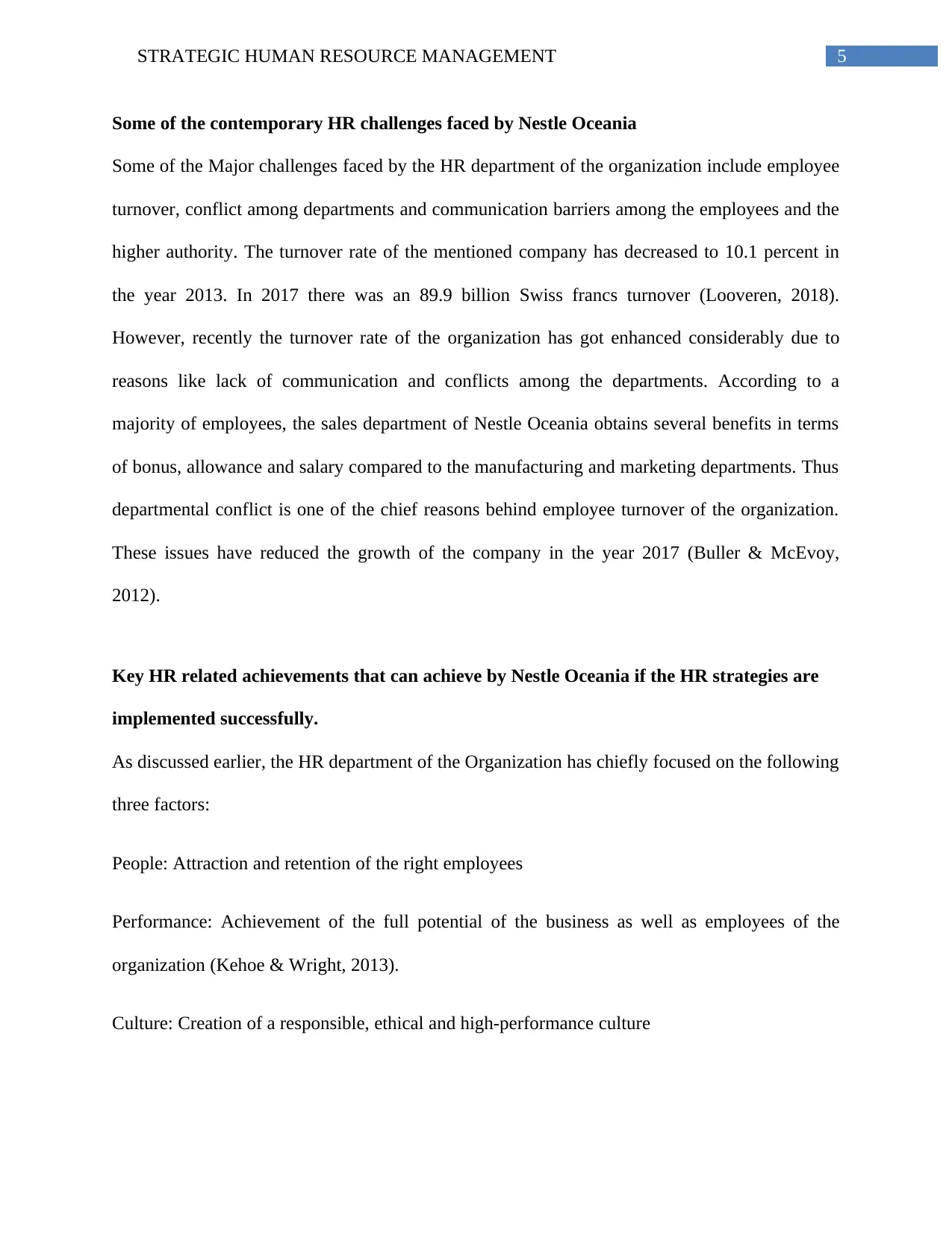
5STRATEGIC HUMAN RESOURCE MANAGEMENT
Some of the contemporary HR challenges faced by Nestle Oceania
Some of the Major challenges faced by the HR department of the organization include employee
turnover, conflict among departments and communication barriers among the employees and the
higher authority. The turnover rate of the mentioned company has decreased to 10.1 percent in
the year 2013. In 2017 there was an 89.9 billion Swiss francs turnover (Looveren, 2018).
However, recently the turnover rate of the organization has got enhanced considerably due to
reasons like lack of communication and conflicts among the departments. According to a
majority of employees, the sales department of Nestle Oceania obtains several benefits in terms
of bonus, allowance and salary compared to the manufacturing and marketing departments. Thus
departmental conflict is one of the chief reasons behind employee turnover of the organization.
These issues have reduced the growth of the company in the year 2017 (Buller & McEvoy,
2012).
Key HR related achievements that can achieve by Nestle Oceania if the HR strategies are
implemented successfully.
As discussed earlier, the HR department of the Organization has chiefly focused on the following
three factors:
People: Attraction and retention of the right employees
Performance: Achievement of the full potential of the business as well as employees of the
organization (Kehoe & Wright, 2013).
Culture: Creation of a responsible, ethical and high-performance culture
Some of the contemporary HR challenges faced by Nestle Oceania
Some of the Major challenges faced by the HR department of the organization include employee
turnover, conflict among departments and communication barriers among the employees and the
higher authority. The turnover rate of the mentioned company has decreased to 10.1 percent in
the year 2013. In 2017 there was an 89.9 billion Swiss francs turnover (Looveren, 2018).
However, recently the turnover rate of the organization has got enhanced considerably due to
reasons like lack of communication and conflicts among the departments. According to a
majority of employees, the sales department of Nestle Oceania obtains several benefits in terms
of bonus, allowance and salary compared to the manufacturing and marketing departments. Thus
departmental conflict is one of the chief reasons behind employee turnover of the organization.
These issues have reduced the growth of the company in the year 2017 (Buller & McEvoy,
2012).
Key HR related achievements that can achieve by Nestle Oceania if the HR strategies are
implemented successfully.
As discussed earlier, the HR department of the Organization has chiefly focused on the following
three factors:
People: Attraction and retention of the right employees
Performance: Achievement of the full potential of the business as well as employees of the
organization (Kehoe & Wright, 2013).
Culture: Creation of a responsible, ethical and high-performance culture
⊘ This is a preview!⊘
Do you want full access?
Subscribe today to unlock all pages.

Trusted by 1+ million students worldwide
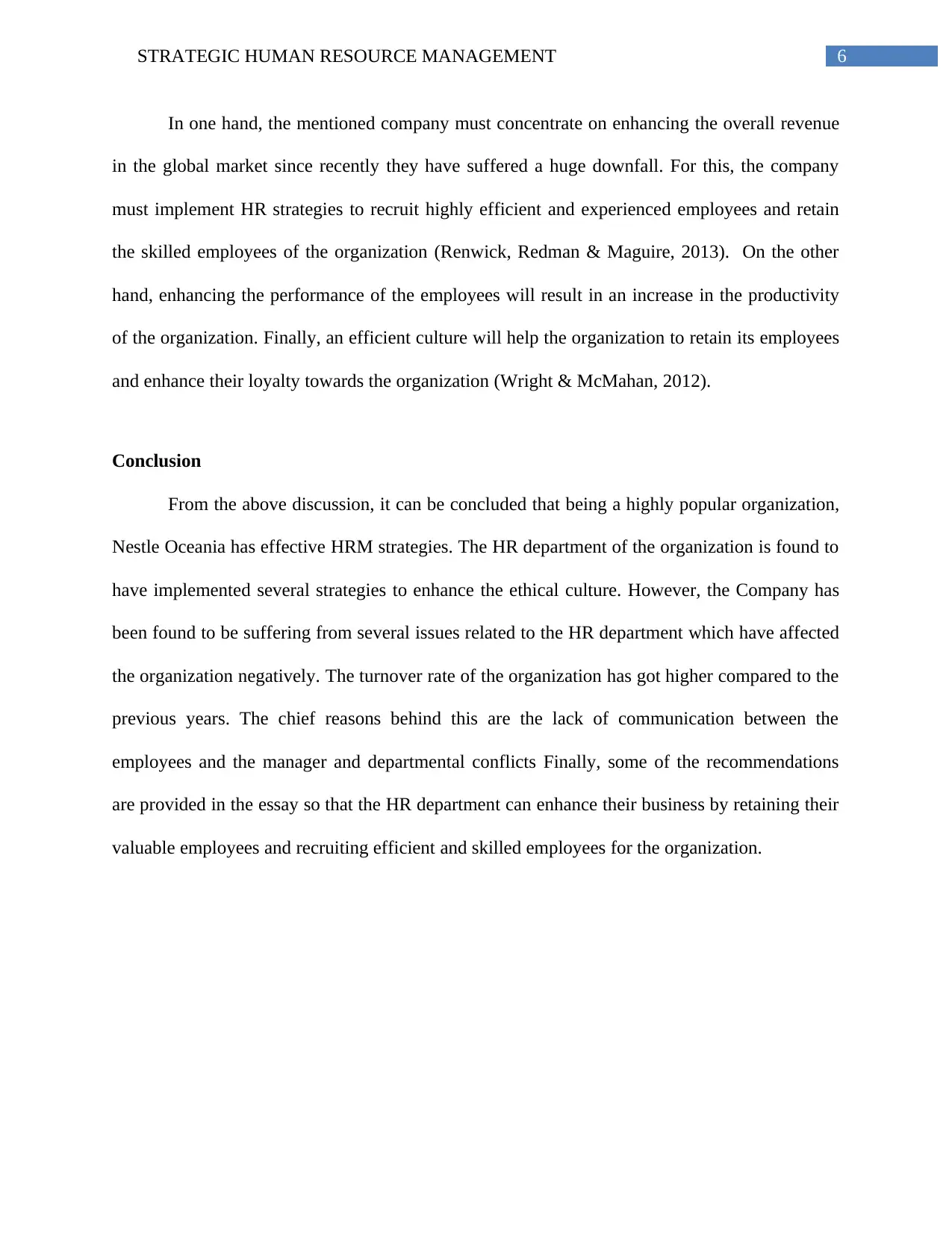
6STRATEGIC HUMAN RESOURCE MANAGEMENT
In one hand, the mentioned company must concentrate on enhancing the overall revenue
in the global market since recently they have suffered a huge downfall. For this, the company
must implement HR strategies to recruit highly efficient and experienced employees and retain
the skilled employees of the organization (Renwick, Redman & Maguire, 2013). On the other
hand, enhancing the performance of the employees will result in an increase in the productivity
of the organization. Finally, an efficient culture will help the organization to retain its employees
and enhance their loyalty towards the organization (Wright & McMahan, 2012).
Conclusion
From the above discussion, it can be concluded that being a highly popular organization,
Nestle Oceania has effective HRM strategies. The HR department of the organization is found to
have implemented several strategies to enhance the ethical culture. However, the Company has
been found to be suffering from several issues related to the HR department which have affected
the organization negatively. The turnover rate of the organization has got higher compared to the
previous years. The chief reasons behind this are the lack of communication between the
employees and the manager and departmental conflicts Finally, some of the recommendations
are provided in the essay so that the HR department can enhance their business by retaining their
valuable employees and recruiting efficient and skilled employees for the organization.
In one hand, the mentioned company must concentrate on enhancing the overall revenue
in the global market since recently they have suffered a huge downfall. For this, the company
must implement HR strategies to recruit highly efficient and experienced employees and retain
the skilled employees of the organization (Renwick, Redman & Maguire, 2013). On the other
hand, enhancing the performance of the employees will result in an increase in the productivity
of the organization. Finally, an efficient culture will help the organization to retain its employees
and enhance their loyalty towards the organization (Wright & McMahan, 2012).
Conclusion
From the above discussion, it can be concluded that being a highly popular organization,
Nestle Oceania has effective HRM strategies. The HR department of the organization is found to
have implemented several strategies to enhance the ethical culture. However, the Company has
been found to be suffering from several issues related to the HR department which have affected
the organization negatively. The turnover rate of the organization has got higher compared to the
previous years. The chief reasons behind this are the lack of communication between the
employees and the manager and departmental conflicts Finally, some of the recommendations
are provided in the essay so that the HR department can enhance their business by retaining their
valuable employees and recruiting efficient and skilled employees for the organization.
Paraphrase This Document
Need a fresh take? Get an instant paraphrase of this document with our AI Paraphraser
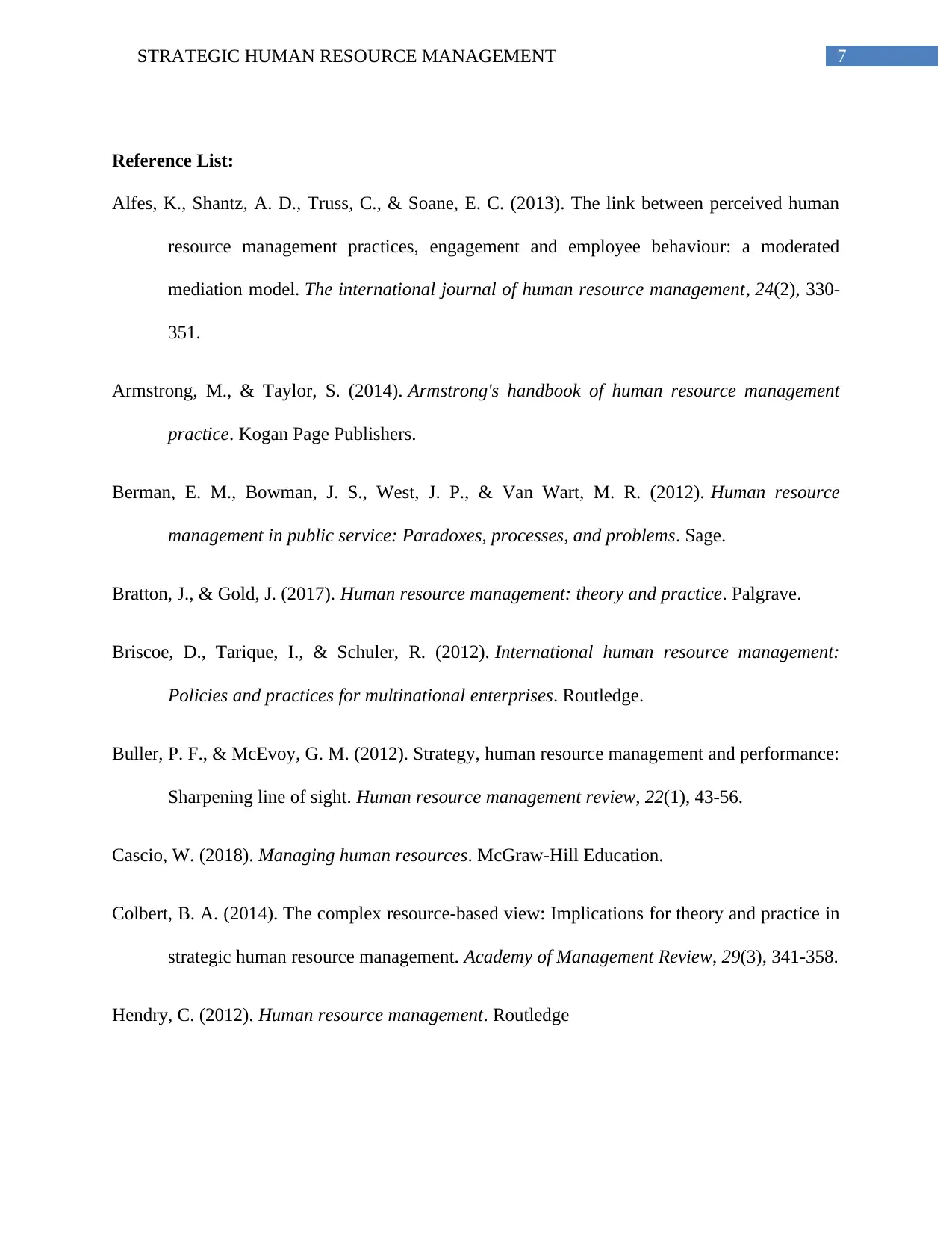
7STRATEGIC HUMAN RESOURCE MANAGEMENT
Reference List:
Alfes, K., Shantz, A. D., Truss, C., & Soane, E. C. (2013). The link between perceived human
resource management practices, engagement and employee behaviour: a moderated
mediation model. The international journal of human resource management, 24(2), 330-
351.
Armstrong, M., & Taylor, S. (2014). Armstrong's handbook of human resource management
practice. Kogan Page Publishers.
Berman, E. M., Bowman, J. S., West, J. P., & Van Wart, M. R. (2012). Human resource
management in public service: Paradoxes, processes, and problems. Sage.
Bratton, J., & Gold, J. (2017). Human resource management: theory and practice. Palgrave.
Briscoe, D., Tarique, I., & Schuler, R. (2012). International human resource management:
Policies and practices for multinational enterprises. Routledge.
Buller, P. F., & McEvoy, G. M. (2012). Strategy, human resource management and performance:
Sharpening line of sight. Human resource management review, 22(1), 43-56.
Cascio, W. (2018). Managing human resources. McGraw-Hill Education.
Colbert, B. A. (2014). The complex resource-based view: Implications for theory and practice in
strategic human resource management. Academy of Management Review, 29(3), 341-358.
Hendry, C. (2012). Human resource management. Routledge
Reference List:
Alfes, K., Shantz, A. D., Truss, C., & Soane, E. C. (2013). The link between perceived human
resource management practices, engagement and employee behaviour: a moderated
mediation model. The international journal of human resource management, 24(2), 330-
351.
Armstrong, M., & Taylor, S. (2014). Armstrong's handbook of human resource management
practice. Kogan Page Publishers.
Berman, E. M., Bowman, J. S., West, J. P., & Van Wart, M. R. (2012). Human resource
management in public service: Paradoxes, processes, and problems. Sage.
Bratton, J., & Gold, J. (2017). Human resource management: theory and practice. Palgrave.
Briscoe, D., Tarique, I., & Schuler, R. (2012). International human resource management:
Policies and practices for multinational enterprises. Routledge.
Buller, P. F., & McEvoy, G. M. (2012). Strategy, human resource management and performance:
Sharpening line of sight. Human resource management review, 22(1), 43-56.
Cascio, W. (2018). Managing human resources. McGraw-Hill Education.
Colbert, B. A. (2014). The complex resource-based view: Implications for theory and practice in
strategic human resource management. Academy of Management Review, 29(3), 341-358.
Hendry, C. (2012). Human resource management. Routledge
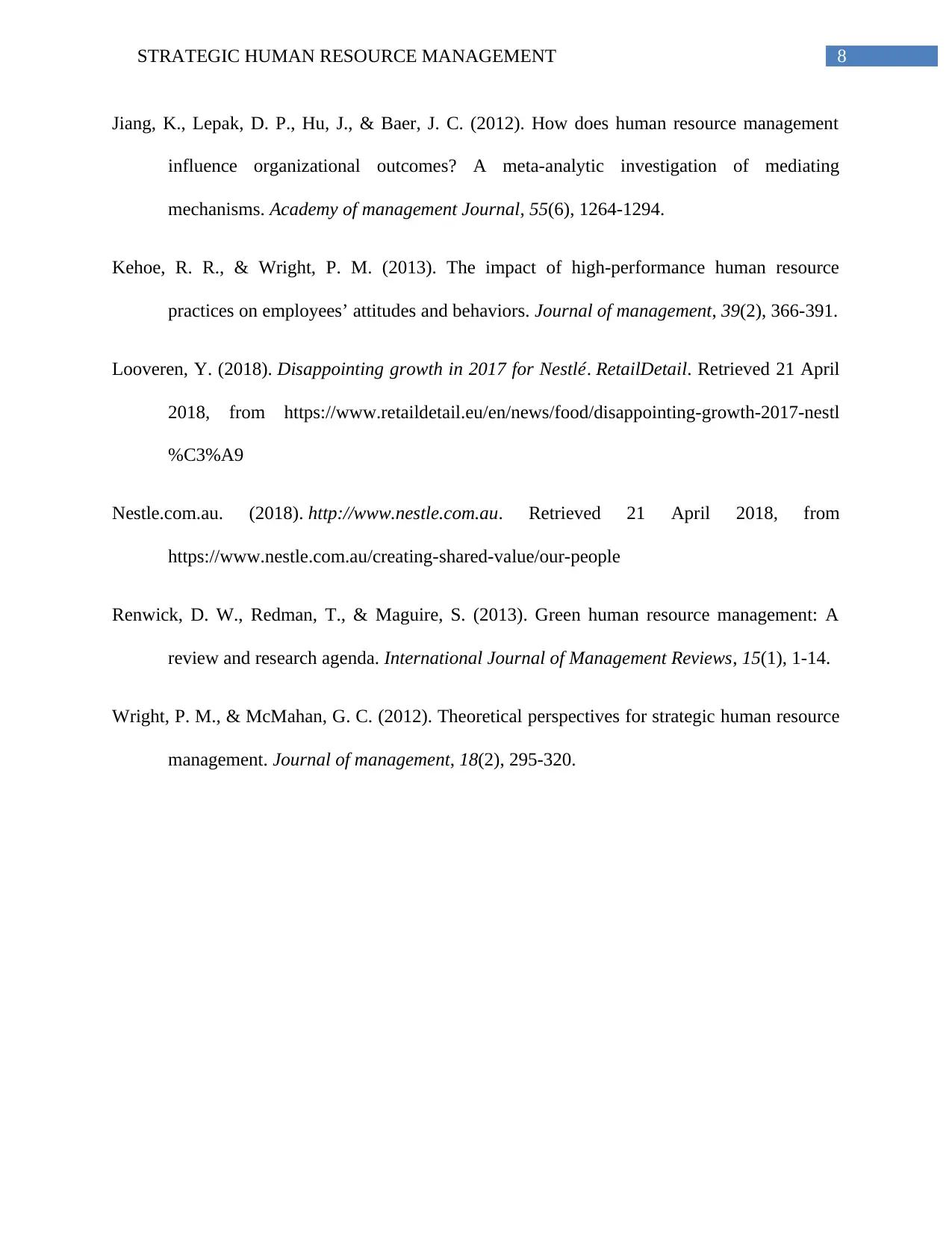
8STRATEGIC HUMAN RESOURCE MANAGEMENT
Jiang, K., Lepak, D. P., Hu, J., & Baer, J. C. (2012). How does human resource management
influence organizational outcomes? A meta-analytic investigation of mediating
mechanisms. Academy of management Journal, 55(6), 1264-1294.
Kehoe, R. R., & Wright, P. M. (2013). The impact of high-performance human resource
practices on employees’ attitudes and behaviors. Journal of management, 39(2), 366-391.
Looveren, Y. (2018). Disappointing growth in 2017 for Nestlé. RetailDetail. Retrieved 21 April
2018, from https://www.retaildetail.eu/en/news/food/disappointing-growth-2017-nestl
%C3%A9
Nestle.com.au. (2018). http://www.nestle.com.au. Retrieved 21 April 2018, from
https://www.nestle.com.au/creating-shared-value/our-people
Renwick, D. W., Redman, T., & Maguire, S. (2013). Green human resource management: A
review and research agenda. International Journal of Management Reviews, 15(1), 1-14.
Wright, P. M., & McMahan, G. C. (2012). Theoretical perspectives for strategic human resource
management. Journal of management, 18(2), 295-320.
Jiang, K., Lepak, D. P., Hu, J., & Baer, J. C. (2012). How does human resource management
influence organizational outcomes? A meta-analytic investigation of mediating
mechanisms. Academy of management Journal, 55(6), 1264-1294.
Kehoe, R. R., & Wright, P. M. (2013). The impact of high-performance human resource
practices on employees’ attitudes and behaviors. Journal of management, 39(2), 366-391.
Looveren, Y. (2018). Disappointing growth in 2017 for Nestlé. RetailDetail. Retrieved 21 April
2018, from https://www.retaildetail.eu/en/news/food/disappointing-growth-2017-nestl
%C3%A9
Nestle.com.au. (2018). http://www.nestle.com.au. Retrieved 21 April 2018, from
https://www.nestle.com.au/creating-shared-value/our-people
Renwick, D. W., Redman, T., & Maguire, S. (2013). Green human resource management: A
review and research agenda. International Journal of Management Reviews, 15(1), 1-14.
Wright, P. M., & McMahan, G. C. (2012). Theoretical perspectives for strategic human resource
management. Journal of management, 18(2), 295-320.
⊘ This is a preview!⊘
Do you want full access?
Subscribe today to unlock all pages.

Trusted by 1+ million students worldwide
1 out of 9
Related Documents
Your All-in-One AI-Powered Toolkit for Academic Success.
+13062052269
info@desklib.com
Available 24*7 on WhatsApp / Email
![[object Object]](/_next/static/media/star-bottom.7253800d.svg)
Unlock your academic potential
Copyright © 2020–2025 A2Z Services. All Rights Reserved. Developed and managed by ZUCOL.




